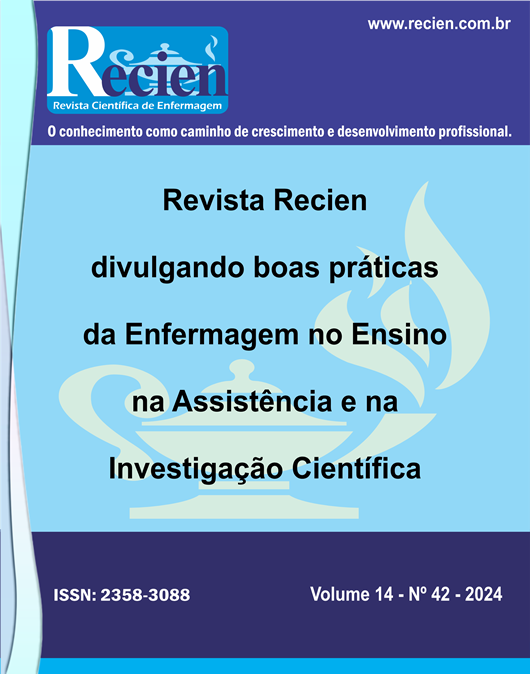Contributos da realidade virtual na reabilitação motora de idosos
DOI:
10.24276/rrecien2024.14.42.786Palavras-chave:
Realidade Virtual, Reabilitação, Destreza Motora, IdosoResumo
Conhecer os contributos da realidade virtual na reabilitação motora de idosos. Estudo realizado segundo o protocolo scoping Review, e os princípios preconizados pelo Joanna Briggs Institute e Preferred Reporting Items for Systematic Reviews and Meta-Analyses Extension for Scoping Reviews. Os critérios de inclusão foram definidos pela mnemónica “PCC” (população, conceito, contexto). Foram incluídos artigos em inglês, espanhol e português, publicados nos 5 anos anteriores ao presente estudo. A realidade virtual, pode ser usada como ferramenta de reabilitação ortopédica para a recuperação funcional motora. Produz aumentos no volume de substância cinzenta nas regiões motora e pré-motora do hemisfério afetado após acidente vascular cerebral. Melhora o processo cognitivo neuronal de antecipação motora e reduz a ativação compensatória do hemisfério contralateral. A realidade virtual é útil e eficaz, principalmente, para os clientes com sequelas de acidente vascular cerebral, doença de Parkinson, e do foro ortopédico.
Descritores: Realidade Virtual, Reabilitação, Destreza Motora, Idoso.
Contributions of virtual reality in the motor rehabilitation of elderly people
Abstract: To find out what virtual reality can contribute to motor rehabilitation in the elderly. This study was carried out according to the scoping review protocol and the principles recommended by the Joanna Briggs Institute and the Preferred Reporting Items for Systematic Reviews and Meta-Analyses Extension for Scoping Reviews. The inclusion criteria were defined by the mnemonic “PCC” (population, concept, context). Articles in English, Spanish and Portuguese published in the 5 years prior to the present study were included. Virtual reality, can be used as an orthopedic rehabilitation tool for motor functional recovery. It produces increases in gray matter volume in the motor and premotor regions of the affected hemisphere after stroke. It improves the neuronal cognitive process of motor anticipation and reduces compensatory activation of the contralateral hemisphere. Virtual reality is useful and effective, especially for clients with stroke sequelae, Parkinson's disease and orthopedic conditions.
Descriptors: Virtual Reality, Rehabilitation, Motor Dexterity, Elderly.
Aportes de la realidad virtual en la rehabilitación motora de las personas mayores
Resumen: Averiguar qué puede aportar la realidad virtual a la rehabilitación motora en ancianos. Este estudio se llevó a cabo según el protocolo de revisión exploratoria y los principios recomendados por el Instituto Joanna Briggs y la Extensión para revisiones exploratorias de Preferred Reporting Items for Systematic Reviews and Meta-Analyses. Los criterios de inclusión se definieron mediante la nemotecnia «PCC» (population, concept, context). Se incluyeron artículos en inglés, español y portugués publicados en los 5 años anteriores al presente estudio. La realidad virtual, puede ser utilizada como herramienta de rehabilitación ortopédica para la recuperación funcional motora. Produce aumentos del volumen de materia gris en las regiones motoras y premotoras del hemisferio afectado tras un ictus. Mejora el proceso cognitivo neuronal de anticipación motora y reduce la activación compensatoria del hemisferio contralateral. La realidad virtual es útil y eficaz, especialmente para clientes con secuelas de ictus, enfermedad de Parkinson y afecciones ortopédicas.
Descriptores: Realidad Virtual, Rehabilitación, Destreza Motora, Ancianos.
Downloads
Referências
Bermo MS, Patterson D, Sharar S, Hoffman H, Lewis D. Virtual reality to relieve pain in burn patients undergoing imaging and treatment. Topics in Magnetic Resonance Imaging. Topics in Magnetic Resonance Imaging. 2020; 29(4):203-208.
Freitas N, Agnol S, Kich C, Mascarenhas L. Efeitos de um protocolo de exercícios de realidade virtual no equilíbrio e independência funcional de indivíduos idosos com Doença de Parkinson – estudo clínico. Rev Kairós: Gerontologia. 2018; 21(4):259-275.
Bruijn S, Meijer O, Beek PJ, Dieen J. Assessing the stability of human locomotion: a review of current measures. JR Soc Interface. 2013; 10:20120999.
Santana C, Lins O, Sanguinetti D, Silva F, Angelo T, Coriolano M, et al. Efeitos do tratamento com realidade virtual não imersiva na qualidade de vida de indivíduos com Parkinson. Rev Bas Geiat Geontol. 2015; 18(1):49-58.
Barata IMS. Realidade virtual: uma estratégia para controlo da dor na pessoa hospitalizada. Disponível em: <https://repositorio.ucp.pt/handle/10400.14/37389>.
Rocha TBX. A utilização da realidade virtual na reabilitação: uma proposta para aquisição de habilidades motoras e cognitivas. 2023. Disponível em: <https://bdtd.ibict.br/vufind/Record/UFF-2_78f82173be9cbc2773f1e89c3d1f29c9>.
Peters M, Marnie C, Tricco A, Pollock D, Munn Z, Alexander L, et al. Updated methodological guidance for the conduct of scoping reviews. JBI Evidence Synthesis. 2020; 18(10):2119-2126.
Matamala-Gomez M, Slater M, Sanchez-Vives MV. Impact of virtual embodiment and exercises on functional ability and range of motion in orthopedic rehabilitation. Scientific Reports. 2022; 12(5046).
Kim BR, Chun M, Kim LS, Park JY. Effect of virtual reality on cognition in stroke patients. Annals of Rehabilitation Medicine. 2011; 35(4):450-459.
Marques D, Venancio D, Santos L, Pinho G, Martins T, Lacerda K, et al. Efeitos do treino de marcha com assistência robótica em adultos pós acidente vascular cerebral. Research, Society and Development. 2022; 11(16):e120111637890.
Silva JPLN, Novaes LFM, Santos LCR, Galindo BP, Cavalcante M, Araújo BCG, et al. Effects of conventional and virtual reality cardiovascular rehabilitation in body composition and functional capacity of patients with heart diseases: randomized clinical trial. International Journal of Cardiovascular Sciences. 2018; 31(6)619-629.
Cacau LDA, Oliveira GU, Maynard LG, Filho AAA, Silva WM, Neto MLC, et al. The use of the virtual reality as intervention tool in the postoperative of cardiac surgery. Rev Bras Cir Cardiovasc. 2013; 28(2):281-9.
Huang X, Naghdy F, Naghdy G, Du H, Todd CA. The combined effects of adaptive control and virtual reality on robot-assisted fine hand motion rehabilitation in chronic stroke patients: a case study. Journal of Stroke and Cerebrovascular Diseases. 2017; 27(1):221-228.
Oh YB, Kim GW, Han KS, Won Y, Park SH, Seo JH, et al. Efficacy of virtual reality combined with real instrument training for patients with stroke: a randomized controlled trial. Archives of Physical Medicine and Rehabilitation. 2019; 100(8):1400-1408.
Thielbar KO, Lord TJ, Fischer H, Lazzaro EC, Barth KC, Stoykov M, et al. Training finger individuation with a mechatronic-virtual reality system leads to improved fine motor control post-stroke. Journal of Neuro Engineering and Rehabilitation. 2014; 11(171).
Miranda P, Ferreira J, Ferreira B, Santos N, Ítala M, Ribeiro B, et al. O uso da realidade virtual na reabilitação do paciente após acidente vascular encefálico. Rev Bras Desenvolvimento. 2021; 7(10):95350-95365.
Posada-Gómez R, Montaño-Murillo R, Martínez-Sibaja A, Alor-Hernández G, Aguilar-Lasserre A, Reyes-Fernandez M. An interactive system for fine motor rehabilitation. Rehabilitation Nursing. 2018; 43(2):116-124.
Shiri S, Feintuch U, Lorber-Haddad A, Moreh E, Twito D, Tuchner-Arieli M, et al. A novel virtual reality system integrating online self-face viewing and mirror visual feedback for stroke rehabilitation: rationale and feasibility. Topics in Stroke Rehabilitation. 2012; 19(4):277-286.
Adams RJ, Lichter MD, Ellington AL, White M, Armstead K, Patrie J, et al. Virtual activities of daily living for recovery of upper extremity motor function. Transactions on Neural Systems and Rehabilitation Engineering. 2018; 26(1):252-260.
Meireles CV, Ferreira SF, Avelino P, Menezes KKP. Efeitos do treino de realidade virtual na coordenação motora dos membros superiores de indivíduos após acidente vascular encefálico: uma revisão sistemática com meta-análise. Fisioter Pesqui. 2022; 29(1):11-21.
Youze H, Ting Y, Yaqi B, Xiao T, Wu T, Wu J. Computer aided self-regulation learning and cognitive training improve generalization ability of patients with poststroke cognitive impairment. Scientific Reports. 2021; 11(24200).
Albuquerque V, Oliveira A, Pereira C, Lima M, Carvalho G, Silva K. O uso da realidade virtual no equilibrio postural de idosos: revisão da literatura. International Journal of Development Research. 2020; 10(11):41917-41924.
Lemus D, Berry A, Jabeen S, Jayaraman C, Hohl K, et al. Controller synthesis and clinical exploration of wearable gyroscopic actuators to support human balance. Scientific Reports. 2020; 10(10412).
Campo-Prieto P, Cancela-Carral JM, Alsina-Rey B, Rodríguez-Fuentes G. Immersive virtual reality as a novel physical therapy approach for nonagenarians: usability and effects on balance outcomes of a game-based exercise program. J Clin Med. 2022; 11(13):3911.
Alves MLM, Mesquita BS, Morais WS, Leal JC, Satler C, Mendes FADS. Nintendo Wii™ versus Xbox Kinect™ for assisting people with parkinson’s disease. Perceptual and Motor Skills. 2018; 125(3):546-565.
Audi M, Barrozo AL, Perin BO, Frota JB, Braccialli LMP. Realidade virtual como ferramenta para reabilitação: estudo de caso. Rev Educação Especial. 2018; 31(60):153-166.
Ramos R, Dias E, Oliveira L, Guimarães T, Pernambuco A, Chaves C. Realidade virtual na reabilitação de portadores da doença de Parkinson. Fisioter Bras. 2016; 17(3):f:179-i:187.
Publicado
- Visualizações 0
- pdf downloads: 0
Como Citar
Edição
Seção

Este trabalho está licenciado sob uma licença Creative Commons Attribution-NonCommercial-NoDerivatives 4.0 International License.

















